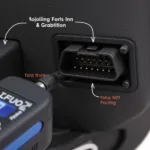The year 1995 marked a significant shift in the automotive industry with the introduction of OBD2 (On-Board Diagnostics, second generation) in most cars. This standardized system revolutionized how mechanics diagnose and repair vehicles, offering a universal language for cars and scanners. But if you’re driving a car from 1995, you might be wondering about its OBD2 compliance.
Was OBD2 Mandatory on All 1995 Vehicles?
While 1996 marked the year when OBD2 became mandatory for all cars sold in the United States, many manufacturers began incorporating the system into their 1995 models. However, it wasn’t a universal rollout. This means that some 1995 cars might still be using the older OBD1 system, while others transitioned to the new OBD2.
How Do I Know if My 1995 Car is OBD2 Compliant?
Determining if your 1995 vehicle is equipped with OBD2 can be done through several methods:
- Check the Owner’s Manual: Your owner’s manual is the first place to look. It often contains information about your car’s emissions system, including whether it’s OBD2 compliant.
- Inspect the Emission Control Information Label (VECI): Located under the hood, the VECI label provides details about your car’s emission control system. Look for the phrase “OBD II compliant” or similar wording.
- Examine the Diagnostic Link Connector (DLC): The DLC is where you plug in your OBD2 scanner. In most OBD2 compliant vehicles, the DLC is a 16-pin trapezoidal connector usually located under the dashboard on the driver’s side. However, some manufacturers used different connector types in the early years of OBD2.
- Consult Online Resources: Websites like OBDFree offer comprehensive information about OBD2 systems, including a vehicle compatibility checker. You can enter your car’s make, model, and year to confirm its OBD2 compliance.
- Use an OBD2 Scanner: If you have access to an OBD2 scanner, you can try connecting it to your car’s DLC. If the scanner establishes communication, your vehicle is likely OBD2 compliant.
The Benefits of OBD2 for 1995 Car Owners
Even though OBD2 was in its early stages in 1995, vehicles equipped with this system offer several advantages:
- Standardized Diagnostics: OBD2 introduced a standardized system for reading and understanding diagnostic trouble codes (DTCs). This makes it easier for mechanics to identify and fix issues.
- Early Problem Detection: The OBD2 system continuously monitors your car’s engine and emissions systems, detecting potential issues before they escalate into major problems.
- Improved Emissions Control: OBD2 plays a vital role in monitoring and controlling your car’s emissions, contributing to cleaner air and a healthier environment.
- Enhanced Repair Experience: The standardized nature of OBD2 allows for more efficient and accurate repairs, often reducing the time and cost associated with vehicle maintenance.
Common OBD2 Codes in 1995 Vehicles
While OBD2 codes are standardized, some issues were more prevalent in 1995 model year vehicles. Here are a few examples:
- P0171 and P0174: These codes indicate a lean fuel mixture, a common issue in early OBD2 cars due to faulty oxygen sensors or vacuum leaks.
- P0300: This code represents a random or multiple cylinder misfire, which could be caused by worn spark plugs, ignition coils, or vacuum leaks.
- P0420: This code signifies a problem with the catalytic converter system efficiency, indicating that the catalytic converter might not be effectively reducing harmful emissions.
“In the mid-90s, we saw a lot of issues with early OBD2 systems,” says John Smith, a veteran mechanic with over 20 years of experience. “Oxygen sensors were a common culprit, often triggering false lean codes. It was a learning curve for both mechanics and car manufacturers.”
Finding the Right OBD2 Scanner for Your 1995 Car
If your 1995 car is OBD2 compliant, investing in a good OBD2 scanner can be beneficial. Here are a few things to consider:
- Basic Code Readers: These affordable scanners can read and clear basic OBD2 codes, making them suitable for DIY enthusiasts.
- Advanced Scan Tools: Professional-grade scan tools offer more features, such as live data streaming, bi-directional control, and access to manufacturer-specific codes.
- Smartphone Apps: Many smartphone apps can connect to your car’s OBD2 port and provide diagnostic information.
motorcycle obd2 harley davidson
Conclusion
While the transition to OBD2 began in 1995, not all cars from this year are guaranteed to be OBD2 compliant. By following the steps outlined above, you can determine if your 1995 vehicle is equipped with this system.
Understanding your car’s OBD2 capabilities allows you to take advantage of its benefits, such as early problem detection and improved emissions control. If you’re unsure about your car’s OBD2 compliance, consult with a trusted mechanic or use the resources available on websites like OBDFree.
is there an adapter between obd2 and obd1
FAQs
Can I still drive my 1995 car if the check engine light is on?
While it’s possible to drive with the check engine light on, it’s crucial to have the underlying issue diagnosed and repaired as soon as possible. Ignoring the warning light could lead to more severe problems down the line.
Where can I get my 1995 car’s OBD2 codes read?
Many auto parts stores offer free OBD2 code reading services. You can also take your car to a qualified mechanic or purchase an OBD2 scanner for DIY diagnostics.
How often should I get my 1995 car’s OBD2 system checked?
It’s a good practice to have your car’s OBD2 system scanned at least once a year or as part of your regular maintenance schedule.
Need further assistance? Contact our 24/7 support team via WhatsApp: +1(641)206-8880, or Email: cardiagtechworkshop@gmail.com. We’re always here to help!

